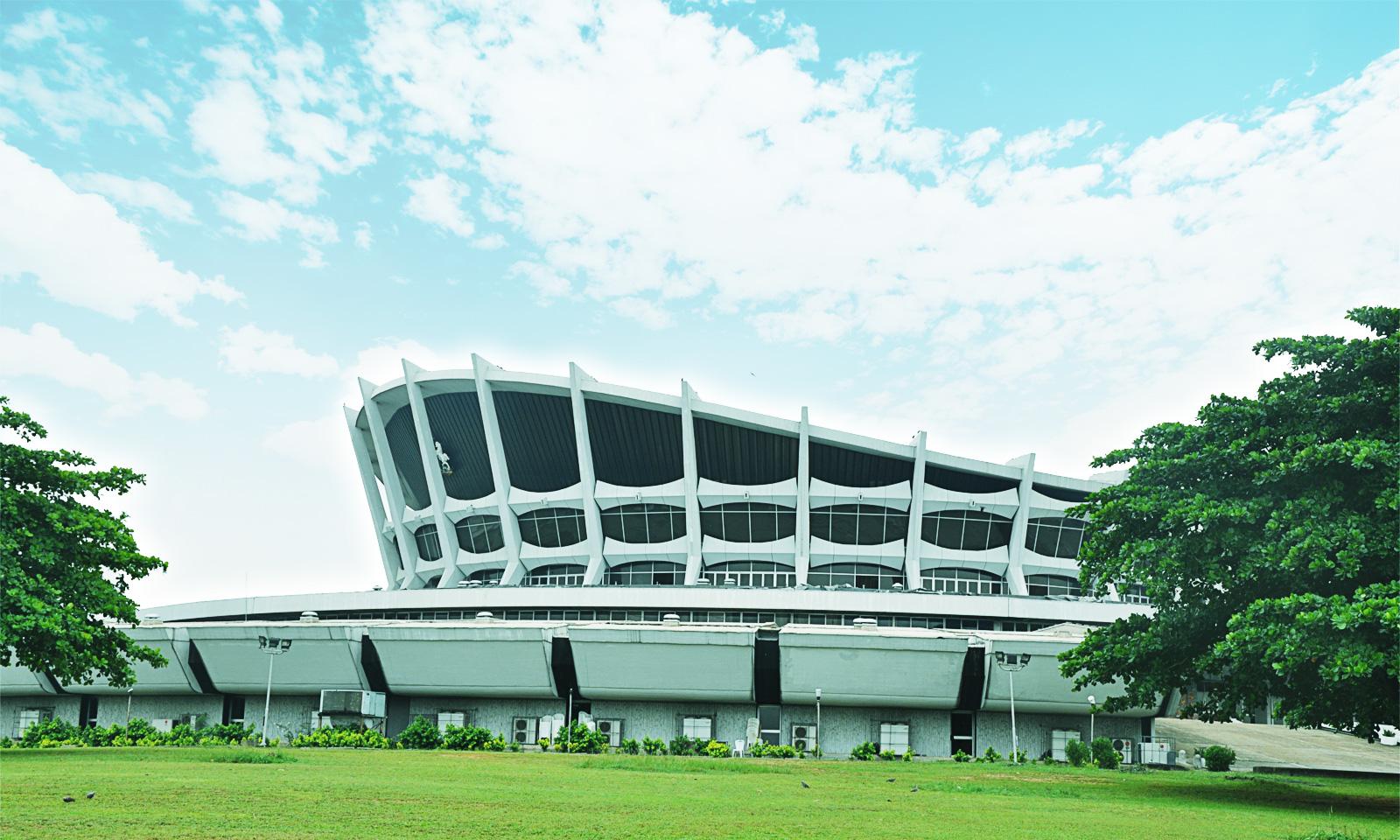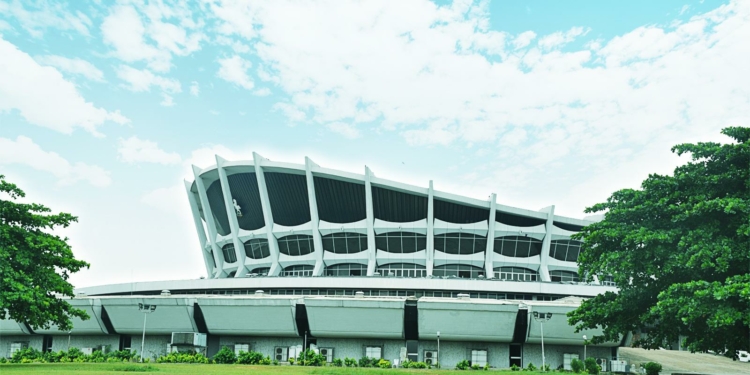Ever wonder about the iconic architecture that dominates the Lagos skyline? That’s the National Theatre, the cultural hub of Lagos since its opening in 1976. It’s hard to believe that this massive concrete structure has been around for over 45 years. You’ve probably driven by it hundreds of times but never stopped to explore the history behind those bold walls. The National Theatre stands as an icon of the nation’s spirit, creativity, and perseverance. Now’s your chance to discover the story of how the National Theatre came to be.
The History of National Theatre Lagos

The National Theatre in Lagos has been an integral part of Nigeria’s arts and culture scene since its establishment in 1976.
The idea for a national Theatre emerged in the late 1950s to showcase Nigerian arts and promote cultural exchange. After delays due to political instability and the civil war, construction began in 1973. The National Theatre Complex opened in 1976 in preparation for the Festival of Arts and Culture (FESTAC) in 1977. The National Theatre was started during the military administration of General Yakubu Gowon and completed during the military government of Olusegun Obasanjo.
By 2021, this edifice had been led by a number of management teams, including Jimmy Folorunso Atte (1991 – August 1999), Prof Babafemi A. Osofisan (2000 – 2004), Dr. Ahmed Parker Yerima (2006 – Aug 2009), Kabir Yusuf (2009 – 2016), George Ufot, (Late) Dr. (Mrs.) Stella Oyedepo, and Sunday Enessi Ododo (2020–present).
Design of the National Theatre Lagos
The National Theatre Lagos has a very unique design that combines both traditional and modern elements. It occupies an area of 23,000 square meters, built over 1.1 million square meters of land in Iganmu.
The National Theatre of Nigeria was developed and built by a Bulgarian construction company (Techno Exporstroy). Alhaji Sule Katagum was a co-owner as well as their chairman. It is similar to the Palace of Culture and Sports in Varna, Bulgaria (finished in 1968), with the National Theatre Lagos, Nigeria being the largest of the two. The National Theatre’s facade was designed, fashioned, and constructed to resemble a military hat. The popular claim that the National Arts Theatre was constructed to resemble the late General Murtala Muhammed’s military peaked cap is merely coincidental. It initially had a 5,000-seat Main Hall with a foldable stage and two capacity cinema halls, all of which were equipped with equipment for simultaneous translation of 8 languages, among other things. Tribal art, pottery, and wood carvings are tastefully incorporated throughout. The overall effect is a perfect fusion of old and new, highlighting Nigeria’s rich cultural heritage while embracing modern esthetics.
The National Theatre Lagos is an iconic landmark and a source of pride for all Nigerians. Its stunning architecture and decor showcase the diversity of Nigerian culture in all its glory. A visit to this magnificent complex is a must for anyone interested in African art, design, and performing arts. Experience the best of tradition and modernity under one roof at the National Theatre Lagos.
Promoting Arts and Culture
For over 45 years, the National Theatre has been pivotal to Nigeria’s creative industry. It has hosted festivals, book fairs, drama competitions, and art exhibitions featuring Nigerian talent. Musical performances at the Theatre have included Fela Kuti, Sunny Ade, and Femi Kuti.
The National Theatre is filled with works by notable modern Nigerian artists, including stained glass walls by Yusuf Grillo and sculptures and paintings by Lamidi Fakeye, Erhabor Emokpai, and others. For a month, it served as one of four locations for the Second World Black and African Festival of Arts and Culture, dubbed FESTAC ’77, a major international festival held between January 15 and February 12. In an extraordinary display of African music, visual art, literature, drama, dance, and religion, the complex hosted 16,000 people from 56 African countries and the diaspora.
Facilities At The National Theatre
The National Theatre’s main auditorium seats over 5,000 and has a diameter of 52 meters; it hosts theatrical performances, concerts, and other live events. It also has a collapsible stage that can be swiftly rebuilt for concerts, meetings, film exhibitions, and many forms of indoor sports competitions. It has a conference hall with 1600 seats that can be utilized for various purposes and redefined for banquets and cocktails, two big exposition halls, and two cinemas with 800 seats each. Several smaller halls are used for meetings, lectures, and exhibitions.
The Theatre complex features 600 artist dressing rooms, a garage for more than 150 cars, 80 offices, four coffee shops, and a buffet. There is central air conditioning, indoor TV and radio systems, booths for simultaneous translation of eight languages, and hectares of lush green lawn all around. The complex generates jobs and economic activity, contributing to Lagos’ status as West Africa’s cultural hub.
Though needing renovation, the National Theatre remains the foremost center for arts and culture in Nigeria. It has showcased the diversity of Nigerian expression and given a platform to generations of artists.
Notable Performances Over the Years
The National Theatre Lagos has hosted many notable performances over the years. The National Theatre is a center for promoting and celebrating Nigerian arts and culture. It has hosted many cultural festivals, dance performances, musical concerts, comedy shows, and more. These events showcase the diversity of Nigeria’s cultural heritage to both local and foreign audiences.
The National Theatre experienced a resurgence of events in the early to mid-1990s when Yoruba ‘home video’ films were shown there. Gbenga Adewusi, Alade Aromire, Ireti, Baba Suwe, Ogogo, and other artists performed at the venue. The influx of Nigerians to the cinema every weekend to watch movies at cheap prices became a thing, but it was accompanied by insecurity, muggings, car thefts, and harassment by neighborhood boys. The region became a terrible place to be at night. Piracy of ‘home videos’ ruined the Theatre tradition for many Nigerians.
The screening of the late Hubert Ogunde’s famous film, ‘Ayanmo,’ in 1994, drew a stampede, but that was the last major event for the main bowl that hosted the film, as the chiller packed up and required over N500 million to restore, which the theatre’s management could not afford due to a lack of activities to sustain its revenue and maintenance targets.
Controversy
Former President Olusegun Obasanjo, who opened the National Theatre as a military leader in 1976, suggested the venue’s privatization in 2001 but was met with significant opposition from Nigerian artists and people. Various alternatives have been proposed throughout the years to renovate and modernize the Theatre. One notable allegation was that the National Theatre was sold to a Dubai company in 2014, which sparked outrage among Nigerians who argued that the Theatre should not be privatized but instead be left in the hands of the government and considered public property.
Renovations and Upgrades
The National Arts Theatre has become a shadow of itself in recent decades, as if the art world has abandoned it. The facility was destroyed by the economic slump and mismanagement in the cultural sector, as well as a lack of maintenance. As performers had to find elsewhere to host their shows, the facility became a symbol of a failed project. The National Arts Theatre was in a state of partial abandonment as it began to deteriorate. Power outages became a major problem, and there were reports of air conditioners not working.
In 2021, the federal government finally approved an intervention by the Central Bank of Nigeria. The signing of the Memorandum of Understanding (MOU) on 14 February heralds a new era for Nigeria’s arts and culture landscape. According to Former CBN Governor Godwin Emefiele, the complex’s refurbishment “would attract investment in the already booming cultural sector and can earn over 20 billion USD yearly from the creative industry, and over one million jobs are expected to be created in five years.”
According to the Former CBN Governor, the Theatre renovation will generate at least 10,000 direct and indirect jobs during the construction period. This is in addition to the 25,000 personnel who will be working on various sections of the monument when the ‘Signature Cluster’ of the monument is completed. The Signature Cluster will have a building for each of the music, film, fashion, and information technology industries. The CBN, through the Bankers Committee, is willing to contribute N21.8 billion to rebuild, refurbish, and operate the National Theatre profitably.
According to the Federal Government, once completed, the National Theatre in Iganmu, Lagos, will be known as the Lagos Creative and Entertainment Center.
Upgrades
Things are looking good for the theatre, considering the level of completion of the renovation work, amid new service routes, nearly 300 units of conveniences, remodeled interior spaces, 3,000 square-meter roof terrace, which had been a major source of leakages is now replaced, while the floors, walls, panels, and ceilings had been stripped back as part of a plan to ensure that all underlying structures are able to support new finishes. The reconstructed theatre also has a new stage infrastructure and future-fit performing arts areas for dance, Theatre, music, and multimedia with changeable acoustics and modern technical equipment adaptive to the needs of audiences, artists, and sponsors.
National Theatre Address/Location in Nigeria
The National Theatre, Iganmu, Surulere, Lagos is basically 4 minutes walk from Costain Bus-stop. This venue is centrally located and accessible near Costain B/stop coming from CMS, Lagos-Badagry Expressway, Apapa road, Ijora Causeway.
Contacts
- Email: info@nationaltheatre.gov.ng
- Phone: +234-(811)-383-1070
- National Theatre, Iganmu, Lagos, Nigeria
If you’re visiting Lagos, the National Theatre should be at the top of your list. This cultural hub provides a glimpse into Nigeria’s rich artistic heritage and vibrant performing arts scene. A trip here is truly an unforgettable experience.
Conclusion
So there you have it, a quick tour through the rich history of National Theatre Lagos. This cultural landmark has stood the test of time and weathered many storms, all while promoting and preserving the diverse artistic heritage of Nigeria. Though it’s faced struggles, National Theatre Lagos remains an important pillar of the community.


Discussion about this post